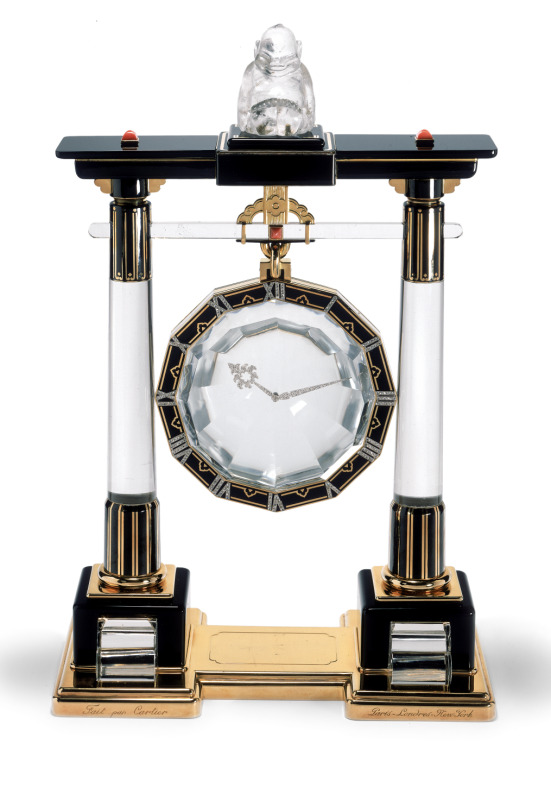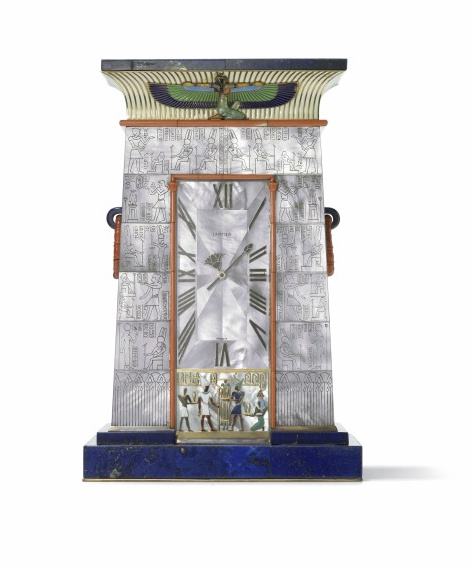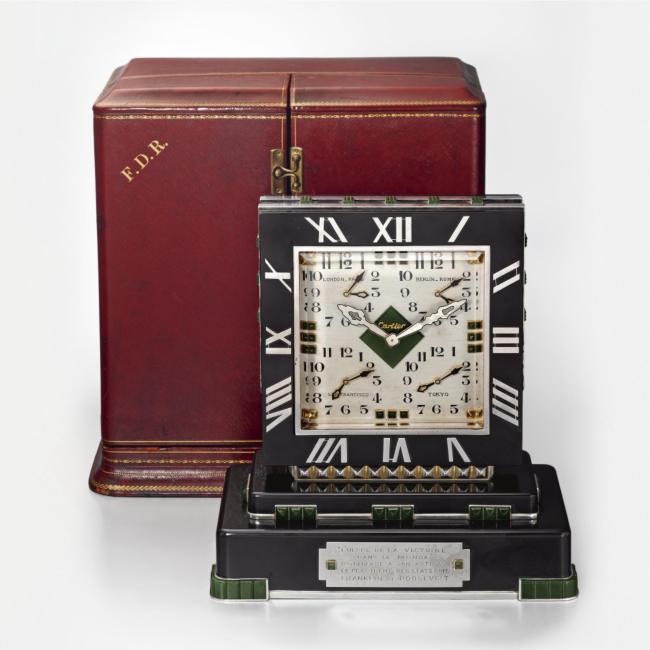From the previously referenced Cartier in America exhibit come these four clocks. Cartier's desk clocks were a celebrated example of the style, which was quite popular throughout the early and middle of the 20th century.
First a Portique Mystery Clock, where there is no apparent connection between the hands and the movement. This one is in Platinum, gold, rock crystal, diamonds, coral, onyx and black enamel and dates to 1923.

(Photo by Nick Welsh, Copyright Cartier Collection)
Second is a more classical guiloche enamel minute repeating desk cubic clock from 1908, in , silver, gold, agate, moonstone, diamonds, platinum, clockwork, and glass. The dial has, for hour indications, the words "Bons Souhaits", roughly meaning "Good Wishes"

(Photo by Joe McDonald, Copyright Fine Arts Museums of San Francisco)
Inspired by the discovery of King Tut's tomb in 1922, the Neo-Egyptian style was in full bloom by the time this striking clock was made in 1927, from gold, silver-gilt, lapis lazuli (base and top), mother of pearl plaques carves with hieroglyphs, carved coral rings and rods. The kneeling winged Egyptian deity at the top is set with emeralds and carnelians, and enameled.

(Photo by Nick Welsh, Copyright Cartier Collection)
Finally a more historical, if less attractive clock. It was given to FDR personally by Pierre Cartier in 1938 and has, in addition to the main dial, four sub-dials, displaying the time in London/Paris, Rome/Berlin, San Fransisco and Tokyo. Made of silver, onyx and nephrite, it has an eight-day movement signed European Watch and Clock Co, a name frequently used by Cartier when importing clocks and watches to the US.

(Photo courtesy of Sotheby's, where the clock was sold in December, 2007 for a record $1,609,000)
(All photos via)
A
First a Portique Mystery Clock, where there is no apparent connection between the hands and the movement. This one is in Platinum, gold, rock crystal, diamonds, coral, onyx and black enamel and dates to 1923.

(Photo by Nick Welsh, Copyright Cartier Collection)
Second is a more classical guiloche enamel minute repeating desk cubic clock from 1908, in , silver, gold, agate, moonstone, diamonds, platinum, clockwork, and glass. The dial has, for hour indications, the words "Bons Souhaits", roughly meaning "Good Wishes"

(Photo by Joe McDonald, Copyright Fine Arts Museums of San Francisco)
Inspired by the discovery of King Tut's tomb in 1922, the Neo-Egyptian style was in full bloom by the time this striking clock was made in 1927, from gold, silver-gilt, lapis lazuli (base and top), mother of pearl plaques carves with hieroglyphs, carved coral rings and rods. The kneeling winged Egyptian deity at the top is set with emeralds and carnelians, and enameled.

(Photo by Nick Welsh, Copyright Cartier Collection)
Finally a more historical, if less attractive clock. It was given to FDR personally by Pierre Cartier in 1938 and has, in addition to the main dial, four sub-dials, displaying the time in London/Paris, Rome/Berlin, San Fransisco and Tokyo. Made of silver, onyx and nephrite, it has an eight-day movement signed European Watch and Clock Co, a name frequently used by Cartier when importing clocks and watches to the US.

(Photo courtesy of Sotheby's, where the clock was sold in December, 2007 for a record $1,609,000)
(All photos via)
A



Hmm. The Egyptian one is surprisingly nice -- a tad gaudy, but better than most of the faux-Egyptian stuff. And the Portique is just plain gorgeous...